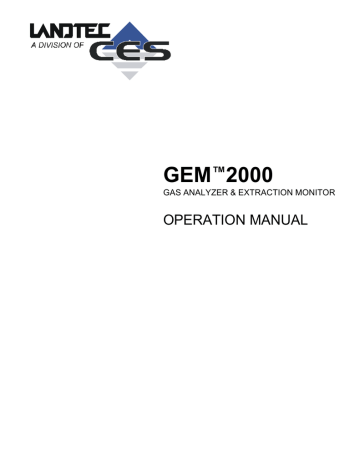
advertisement

GEM™2000 Operation Manual
2. At this point, connect the sample tube (with water trap) from the sample point to the inlet port of the instrument, ensuring the connector ‘clicks’ in to place.
3. Now connect the sample tube to the probe sample port. Do not connect the sample tube to the probe port before connecting to the instrument as this will cause any pressure in the probe
to dissipate and a proper pressure reading will not be taken.
4. The pump may be started or stopped at anytime by way of the ‘ >’ (pump) key and a ‘time-on’ timer will be displayed. The pump should always be stopped using the ‘
↵’ key, before storing a reading.
5. Upon storing the reading, a virtual keyboard will be displayed for any alphanumeric comments to be entered.
6. Disconnect the sample tubing from the probe and proceed from step 1 for the next probe.
Except for the ID code information, which will be stored as ‘- - - - - - - -‘, and probe questions, for each reading the information stored will be the same as that for a reading with an ID.
A tone will sound and a flashing bell will be displayed next to the appropriate gas reading value if a preset alarm condition has been exceeded.
4.5 Temperature Probe Reading
The GEM™2000 has the facility to automatically display and record the probe temperature via an optional temperature probe (TP-100). When a temperature probe is fitted to the RS232 Communication Socket, the temperature will be displayed in the read gas levels screen and recorded with all other data. The temperature probe is part of the GEM™2000 UL certification and is therefore certified for use under the same conditions as the instrument.
4.6 Cross-Gas Effects
4.6.1 Methane, Carbon Dioxide and Oxygen
The Methane reading is filtered to an infrared absorption frequency of 3.41
µ m (nominal), the frequency specific to hydrocarbon bonds. Instruments are calibrated using certified Methane mixtures and will give correct readings provided there are no other hydrocarbon gasses present within the sample (e.g. ethane, propane, butane, etc.). If there are other hydrocarbons present, the Methane reading will be higher (never lower) than the actual Methane concentration being monitored.
The extent to which the Methane reading is affected depends upon the concentration of the Methane in the sample and the concentration of the other hydrocarbons. The effect is non-linear and difficult to predict.
The Carbon Dioxide reading is filtered to an infrared absorption frequency of 4.29µm (nominal), the frequency specific to Carbon Dioxide. Therefore, any other gases usually found on landfill sites will not affect the Carbon Dioxide reading.
The Oxygen sensor is a newly developed galvanic cell type and suffers virtually no influence from CO
2
, CO,
H
2
S, NO
2
, SO
2 or H
2
, unlike many other types of Oxygen cell.
The infrared sensors will not be "poisoned" by other hydrocarbons. Normal operation will resume as soon as the gas sample has been purged.
Note - there has been one reported incident of a high reading due to the presence of Carbon Disulphide, which has a similar absorption frequency to Carbon Dioxide.
Page 12
advertisement
* Your assessment is very important for improving the workof artificial intelligence, which forms the content of this project
Related manuals
advertisement
Table of contents
- 8 WARNING Displayed
- 8 ERROR Displayed
- 13 Zero Channels
- 13 Span Channels
- 13 Factory Settings
- 13 Last Field Cal
- 16 Methane, Carbon Dioxide and Oxygen
- 17 S, CO and other Optional Gas Pods
- 20 3.0CS
- 24 Comments
- 26 Entering ID’s
- 29 Editing ID’s
- 31 Delete ID’s
- 32 Re-sequencing
- 34 Readings
- 37 Site Questions
- 42 Instrument Settings
- 48 Resource Links
- 50 Controlling by Wellhead Valve Position
- 50 Controlling by Wellhead Vacuum
- 50 Controlling by Gas Composition
- 50 Controlling by Flow Rate